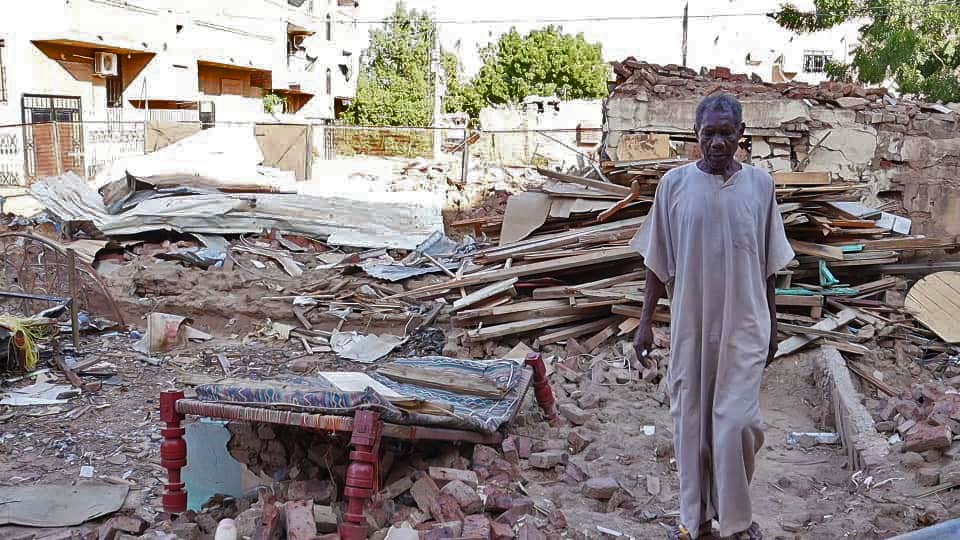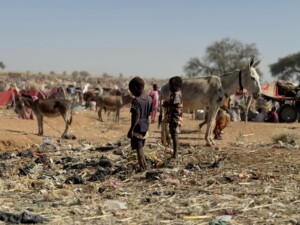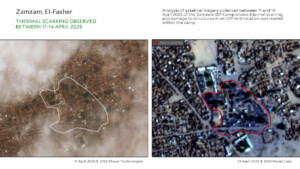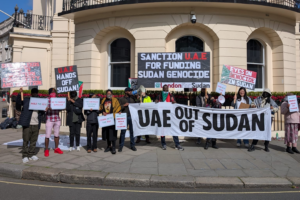Sudan war: battles reported from Sennar, North Darfur, and Khartoum

Homes and shops in Burri in Khartoum destroyed by bombing, October 6 (File photo: Saeed Abdelmajidbdelmajeed)
Battles between the Sudanese Armed Forces (SAF) and the Rapid Support Forces (RSF) raged in the strategically important area of Jebel Moya in Sennar yesterday. The area north of Kutum town in North Darfur, occupied by the Joint Force of Armed Struggle Movements, witnessed clashes, while SAF-RSF fighting continued in central Khartoum. Drones reportedly targeted Atbara Airport in northern Sudan.
Speaking to Radio Dabanga yesterday from the area of Jebel Moya along the Sennar-El Gezira border, sources reported that the SAF regained control of Fangoga and Jebel El Aawar villages, with the RSF retreating to Jebel Moya in the western direction. The battles were still ongoing, they said.
Social media posts showed pictures and videos of army officers and soldiers entering Jebel Moya. One of them said from inside a mosque in Jebel Moya that they had taken control of the area. RSF paramilitaries on social media denied the news.
The RSF occupied Jebel Moya in end June, and were thus able to control the road leading from eastern Sudan to White Nile state and North Kordofan.
Strategic importance
The Jebel Moya area is of great military importance in the current war, a military expert told Radio Dabanga.
“It is located in the centre of three major army bases: the 17th Infantry Division together with the 265th Air Force Brigade in Sennar to the east, the 18th Infantry Division in Kosti to the west, and the 1st Infantry Division, which the army withdrew from Wad Madani [the capital of El Gezira] in December and is currently stationed in El Managil in northwestern El Gezira,” he explained. “The area also contains the largest air base in southern Sudan, the Kenana Air Base, which is about 21 kilometres southeast of Rabak.”
He said that “SAF control over the area allows them to control supply routes to the south of El Gezira and White Nile state, after the supply route via Omdurman-Kosti became impossible due to the RSF’s occupation of the areas south of Khartoum state, from El Salha in southern Omdurman to Jebel Aulia in southern Khartoum.
“In addition, the army cannot use the road east of the White Nile due to the paramilitaries’ control over the area extending from El Shajara to El Geteina.”
After seizing Jebel Moya, the RSF were able to take control of almost all parts of Sennar, except Sennar town and the Maiurno.
The UN World Food Programme (WFP) on July 6 expressed its concerns that increased fighting in Sennar could sever key routes for humanitarian aid from Port Sudan.
Bir Mazza/El Mazroub
Clashes also took place between the RSF and the Darfur Joint Force of Armed Struggle Movements (aka Sudanese Joint Force*), made up of combatants of the SLM-MM, JEM-GI and smaller rebel groups, in Kutum in North Darfur.
A resident of El Mazroub told Radio Dabanga on Wednesday that fighters of the Joint Force entered Kutum locality from several directions, and took control of the area.
The Joint Force, however, claims that El Mazroub area is the same area as Bir Mazza, taken on Wednesday, saying that the RSF confused the name of Bir Mazza with El Mazroub.
Khartoum
Military sources reported violent SAF-RSF battles in El Mogran yesterday morning, where army soldiers are attempting to break the RSF siege of central Khartoum and reach the General Command in the northeastern part of downtown Khartoum.
Members of the paramilitary group posted footage on X, which they said was recorded yesterday, showing that they still control El Mogran, the El Fateh Bridge to Khartoum North, and the El Fateh Tower. SAF loyalists posted video clips by which they claimed that the army has taken control of the Bank of Sudan building.
On Wednesday, the large Sharg El Nil (East Nile) in Khartoum North witnessed several airstrikes on RSF sites in the locality’s neighbourhoods. The RSF responded intensively with anti-aircraft guns.
On September 26, the SAF launched a major ground offensive, supported by artillery and airstrikes, in key areas of Khartoum state. Army soldiers entered Khartoum and Khartoum North (Bahri) from Omdurman via the Halfaya Bridge, the old Iron Bridge and the White Nile Bridge. Two days later, SAF soldiers from Omdurman broke through RSF lines in the west of Khartoum North and reached the El Kadaro military base.
In southwestern Khartoum, army forces in armoured vehicles are attempting to enter the densely populated neighbourhood of El Kalakla.
Médicins Sans Frontières (MSF) Sudan yesterday announced on X the suspension of its medical activities in El Kalakla from September 30 onward “until further notice”, due to increased insecurity in the area.
“This extremely difficult decision to suspend activities at the Shaheed Wada’allah Clinic comes after three incidents of armed robbery within one month – putting the lives of staff and patients at risk. These attacks against healthcare are unacceptable,” the MSF stated in Arabic.
The organisation’s teams continue to work in the nearby Bashair University Hospital and other parts of the city, though also in severely insecure conditions.
Drones over Atbara
In River Nile state, sources reported that three drones targeted Atbara Airport in the early hours of yesterday morning. Ground forces were able to shoot down the drones east of Atbara town, without recording any losses.
Drones have played an increasingly significant role in the ongoing war in Sudan. In late July, the head of the ruling junta and de facto president of Sudan, Lt Gen Abdelfattah El Burhan, survived an apparent assassination attempt by drone attack during a parade in Red Sea state.
Recently, more than 45 passengers were killed in a drone strike that targeted a passenger bus in the area between Rabak, the capital of White Nile state, and Khartoum.
Human Rights Watch (HRW) has called for an expansion of the Sudan arms embargo, after it published a report in September which found that the warring parties in Sudan “have access to and are using modern, foreign-made weapons and equipment”, including drones, which were acquired after the war broke out on April 15, 2023.
* The Darfur Joint Force was formed in June 2022, as agreed on in the 2020 Juba Peace Agreement (JPA), to protect the people in the region. The force was made up of fighters of the Sudan Liberation Movement faction headed by Darfur Governor Minni Minawi (SLM-MM), the JEM faction led by Finance Minister Gibril Ibrahim (JEM-GI), and several small rebel groups that signed the JPA. These movements renounced their neutrality in November last year and are now fighting the RSF alongside the Sudanese army. Since then, Sudanese media speak about the Joint Force of Armed Struggle Movements, while the group’s logo on their X and Facebook accounts says Sudanese Joint Force (and in Arabic Sudanese Joint Forces).











 and then
and then